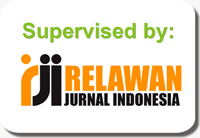Tingkat Kesulitan Dinamis Menggunakan Logika Fuzzy Pada Game Musik Tradisional Jawa Tengah
DOI:
https://doi.org/10.31961/eltikom.v5i2.281Keywords:
dynamic difficulty, fuzzy logic, rhythm Game, traditional songAbstract
ABSTRACT
The culture in Indonesia is very diverse, one of which is traditional songs. However, knowledge of traditional songs is still small. Digital Games can spread knowledge about traditional songs, one of which is Central Javanese traditional songs. However, the Game that is made still has static difficulties, so the Game cannot follow the player's ability, resulting in the player feeling bored and not wanting to continue the Game. To generate dynamic difficulties, methods in artificial intelligence can be applied to Games, one of which is Fuzzy. So in this study proposed the application of dynamic difficulties using Fuzzy Logic in music Games / Rhythm Games. Fuzzy Logic is built based on mathematical values and represents uncertainty, where this logic imitates the human way of thinking. Fuzzy Logic can convert crisp input values into fuzzy sets by performing fuzzification. After the input value is converted, the input will be entered into the set of rules provided. Each rule produces a different output. After the process is complete, the output value will be converted back to the crisp output value. Based on the research conducted, it is found that Fuzzy Logic can be applied to music Games where the Game can follow the player's ability based on the given rules.
Downloads
References
B. Pane, X. Najoan, and S. Paturusi, “Rancang Bangun Aplikasi Game Edukasi Ragam Budaya Indonesia,†Jurnal Teknik Informatika, vol. 12, no. 1, 2017.
K. Aribawa, “Pengembangan Aplikasi Game Musik Tradisional Bali MeGamelan Berbasis Multiplatform,†J. Teknol. Inf. dan Ilmu Komput., vol. 5, no. 1, p. 7, 2018.
D. Aditama, R. P. N. Budiarti, S. N. S. Mardi, and M. Hariadi, “Dynamic Evolution Behavior for Non-Player Character on Space Shooter Game Using NSGA-II,†International Journal of Education and Research, vol. 5, no. 1, pp. 185–198, 2017.
K. Sutanto and Suharjito, “Dynamic difficulty adjustment in Game based on type of player with ANFIS method,†J. Theor. Appl. Inf. Technol., vol. 65, no. 1, pp. 254–260, 2014.
E. Lach, “Dynamic difficulty adjustment for serious Game using modified evolutionary algorithm,†International Conference on Artificial Intelligence and Soft Computing 2017, pp. 370–379, 27 May 2017.
R. Sutoyo, D. Winata, K. Oliviani, and D. M. Supriyadi, “Dynamic Difficulty Adjustment in Tower Defence,†Procedia Comput. Sci., vol. 59, pp. 435–444, 2015.
P. H. Saputro, M. Aristin, and Dy. L. Tyas, “Klasifikasi Lagu Daerah Indonesia Berdasarkan Lirik Menggunakan Metode Tf-IDF Naive Bayes,†J. Teknologi Informasi dan Terapan, vol. 4, no. 1, pp. 45–50, 2017.
K. Ruehl, “A Definition and Brief History of Folk Music,†liveaboutdotcom, 2019. [Online]. Available: https://www.liveabout.com/what-is-folk-music-1322534. [Accessed: 04-Jul-2020].
C. Chris, “Design Techniques and Ideals for Computer Games,†Byte Magazine, Dec-1982. [Online]. Available: https://archive.org/stream/byte-magazine-1982-12/1982_12_BYTE_07-12_Game_Plan_1982#page/n97/mode/2up. [Accessed: 04-Jul-2020].
T. Josh, “Good Idea, Bad Idea: Dynamic Difficulty Adjustment,†Destructoid, 17-Feb-2008. [Online]. Available: https://www.destructoid.com/good-idea-bad-idea-dynamic-difficulty-adjustment-70591.phtml [Accessed: 04-Jul-2020].
V. Novák, I. Perfilieva, and J. MoÄkoÅ™, Mathematical Principles of Fuzzy Logic, December 2014.
L. Purwati Ayuningtias and M. Irfan Jumadi, “Analisa Perbandingan Logic Fuzzy Metode Tsukamoto, Sugeno, Dan Mamdani (Studi Kasus : Prediksi Jumlah Pendaftar Mahasiswa Baru Fakultas Sains Dan Teknologi Universitas Islam Negeri Sunan Gunung Djati Bandung),†J. Tek. Inform., pp. 9–16, 2017.
I. A. Ahmadi, E. M. A. Jonemaro, and M. A. Akbar, “Penerapan Algoritme Logika Fuzzy Untuk Dynamic Difficulty Scaling Pada Game Labirin,†J. Pengemb. Teknol. Inf. dan Ilmu Komput. Univ. Brawijaya, 2018.
A. B. Harisa, H. Haryanto, and H. A. Santoso, “Model Tingkat Kesulitan Dinamis Berbasis Logika Fuzzy,†Semin. Nas. Teknol. Inf. dan Multimed., 2016.
Internet Archive, “Lagu Daerah Jawa Tengah Terlengkap,†Internet Archive, 2012. [Online]. Available: https://archive.org/details/LaguDaerahJawaTengahTerlengkap. [Accessed: 30-May-2020].
Downloads
Published
How to Cite
Issue
Section
License
All accepted papers will be published under a Creative Commons Attribution 4.0 International (CC BY 4.0) License. Authors retain copyright and grant the journal right of first publication. CC-BY Licenced means lets others to Share (copy and redistribute the material in any medium or format) and Adapt (remix, transform, and build upon the material for any purpose, even commercially).




